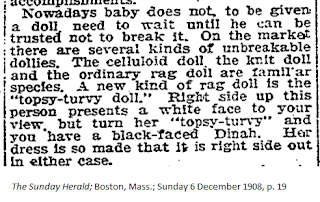© Kathy Duncan, 2022
The popular myth concerning the origin of topsy-turvy dolls was created in the later part of the 20th century and continues to persist in spite of a lack of documentation. All of these creation stories theorize that topsy-turvy dolls originated on southern plantations in the early 19th century. As early as 1982, Wendy Lavitt floated the idea that topsy-turvy dolls were created by slave mothers so that their daughters could have a white doll to play with. Then the doll could be flipped to a black doll if an overseer or master was near. In 1983, Karen Sanchez-Eppler theorized that the dolls were based on Harriett Beecher Stowe's novel Uncle Tom's Cabin, with the black doll representing the character of Topsy and the white doll representing Eva. Twenty years later, in 2008, Kimberly Wallace-Sanders speculated that the dolls were used to train slave girls for their future roles as caregivers of white children.
All of these ideas are based on speculation and what one writer termed "imagining." All of these ideas are now being recycled as fact by a new generation of doll historians. Primary sources are noticeably missing.
A primary source is a document that is created at the time an event happens. Secondary sources are created at some later time and are often a discussion of the primary source. Theories that are created without grounding in a primary source are also secondary sources. Unfortunately, as time goes on, secondary sources take on a life of their own and are too often cited as if they were primary sources.
When we talk about objects that might have been created in the antebellum south by slaves, many might question what primary sources could be available to document them. The usual primary sources that a genealogist might use like the U.S. census, birth and death certificates, marriage records, wills and probates, land deeds, and family bibles are not particularly helpful in seeking the origin of topsy-turvy dolls or any other doll. As it turns out, there are other primary sources that could prove beneficial if they were available. For example, letters, diaries, and photographs might exist in the archive holdings of states, universities, museums, and libraries. Newspaper clippings might shed some light. The most readily available primary sources exist in the form of thousands of pages of interviews that were done with former slaves as the work of the WPA in the 1930s. These documents are housed in the National Archives but are widely available in print form and are known loosely as "slave narratives." They reveal that while a few slave girls had dolls, none of them that I have found so far are described in a way that would indicate they were topsy-turvy dolls. Given the uniqueness of topsy-turvy dolls, if any of these formerly enslaved women had possessed one, she would have surely described it in her interview. By the 1930s, these women had no reason to fear any consequences from having had such a doll.
Excerpts from 23 women's interviews can be read here.
Newspapers can also function as primary sources since they indicate when something first appeared in common usage.
If we turn to newspapers, the first reference to a topsy-turvy doll appeared in the Carson City, Nevada Morning Appeal in December 1893. The dolls were being sold in conjunction with a book titled, Topsys and Turvys. The doll was advertised as "the queerest things you ever saw. You get two dolls or two books for one price." This suggests that people would not have seen a topsy-turvy doll before.
Since the dolls were sold alongside the books, it is helpful to know more about the books. This is the part of the equation that doll historians have neglected. Topsys and Turvys was written by Peter Newell and first published in 1893. Newell had observed one of his children looking at a book upside and decided that it should be possible for a child to look at a book from both directions and have it make sense. In his Topsys and Turvys book, the images are different from each direction so that a farmer becomes a pig and a shepherd becomes a goat.
Newspapers of the day praised the books for their charm and cleverness:
So far, no other reference to the dolls has turned up in 1893, so it may be that some enterprising person saw an opportunity to create a doll inspired by the books and to capitalize on them. It is a shame that it did not occur to that person to copyright their unique doll. Also, no earlier reference to topsy-turvy dolls has turned up in newspaper searches. There is no way of knowing what these first topsy-turvy dolls depicted.
The next reference to topsy-turvy dolls appeared in The Daily Picayune of New Orleans in 1896. Note that Mrs. Crouch attended the reunion of the WCTU in Chicago and reported on her visit to several reformatories. She focused on the work of the Erring Woman's Refuge in Chicago, where the inmates had raised funds by dressing 7,000 topsy-turvy dolls for Christmas sales. She was asked what a topsy-turvey doll was and replied that "it was a rag doll, with one end having the face of child, and when turned down the other had the face of an old black mammy. Thus, whichever way the little one chose to turn her doll it was sure to be dressed." This suggests, again, that the topsy-turvy dolls were not widely known.
In the 1940s, Ann Audubon offered this pattern for 15 cents:














I agree with you. The first idea that dolls were made so enslaved children could play with a white doll and flip it when a white person came around, sounds unbelivable on so many levels. It reminds me of the theory of quilts being made to show runaways which way to run.
ReplyDelete